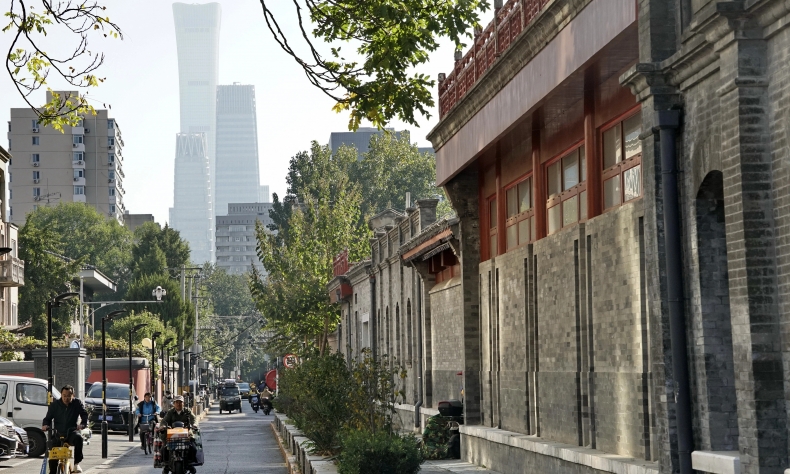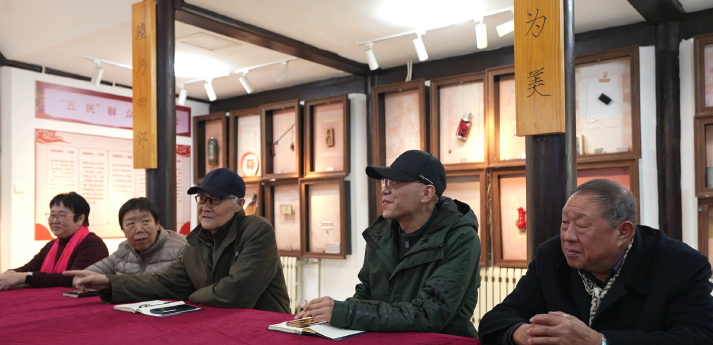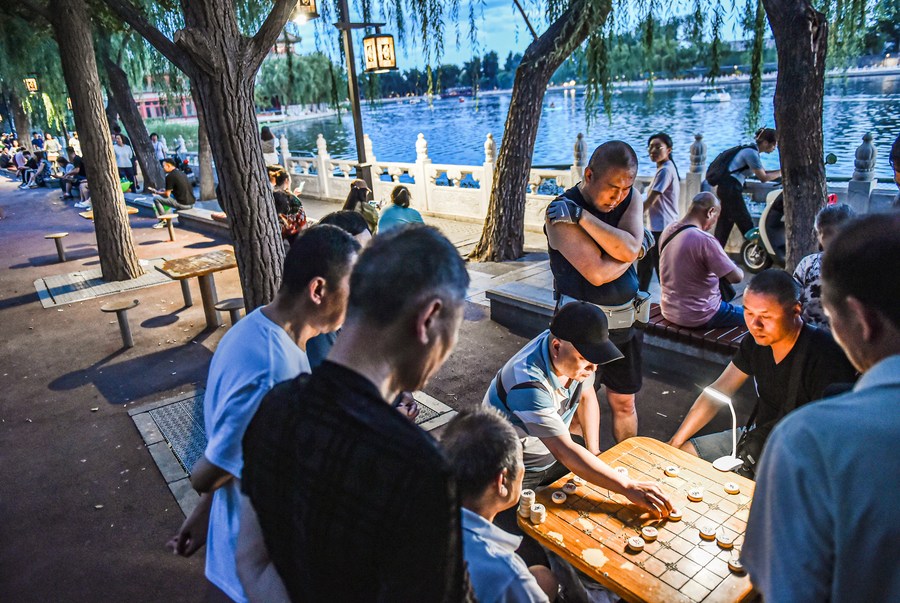Small Spaces, Big Ideas

In a world where urban challenges often seem insurmountable, Caochang offers a hopeful reminder that solutions can be found through cooperation, compassion and community involvement.
When I opened a notebook sitting on the table in the meeting room of one “Hutong Little Congress” in Beijing and read the phrase, “To achieve great work, we need not only strength but also patience,” I immediately realized this was not going to be a simple story.
That humble inscription perfectly encapsulated the essence of what lay ahead: the painstaking process of building consensus within a community grappling with many daily challenges.
Hutong Little Congresses refer to local community councils in the traditional neighborhoods of the Chinese capital, known as hutongs. And in this scenario specifically, it is the Chamber of the Courtyard Council in Caochang, a community located in the city’s Dongcheng District.
The primary-level mechanism is a fine example of China’s whole-process people’s democracy in action. Said democracy refers to China’s governance model where citizens actively participate in every stage of the decision-making process, from consultation and policy formulation to implementation and oversight, ensuring their voices are heard and their needs are met in practice.
The Hutong Little Congress functions as a community forum where residents and local representatives come together to address practical issues impacting their daily lives. These “little congresses” are becoming increasingly common across these neighborhoods as part of urban governance initiatives.
The purpose of the council is clear: to ensure every voice is heard, decisions are made collectively and solutions genuinely reflect the needs of the people. Attending a meeting in late February, my interest was only further piqued as I witnessed the rising intensity of the discussions around me.
Charged discussions
Caochang is a centuries-old area nestled in Dongcheng. This community is a tapestry of 25 hutongs—narrow alleyways that host 616 shared courtyards.
These traditional neighborhoods, rich in history and community spirit, have been revitalized in recent years to balance their architectural heritage with the conveniences of modern life.
The council tackles topics such as infrastructure improvements and public amenities, adapting modern solutions to traditional settings.
February’s gathering centered on the pressing topic that was the need for additional charging stations for electric bicycles. During a heated discussion, one resident raised the question, “Why not build more charging stations in Liu Tiao (Alley No.6)? Wouldn’t that be more convenient for us?”

The response was swift and pointed out the logistical hurdles involved: “Our operational space is very limited. Suitable locations are hard to find. Si Tiao (Alley No.4) is far too narrow. Ba Tiao (Alley No.8) could work, but Liu Tiao still needs a specific spot. Other areas, like Qi Tiao (Alley No.7) or Jiu Tiao (Alley No.9), might be better options.”
As the debate continued, it shifted to the technical challenges at hand. A resident by the surname of Gu proposed a potential solution: installing charging stations in shared spaces. However, he quickly acknowledged the dispute that might arise. “Using the back wall of a courtyard could lead to disagreements with property owners,” he cautioned. Even Ba Tiao (Alley No.8), initially considered ideal, faced resistance from locals. The conversation intensified, and as the room filled with lively exchanges, I seized the moment to pose a question.
“What are the main challenges in executing this kind of project?” I asked Li Zheng, Secretary of the Communist Party of China Committee of Caochang. His response reflected the complexity of balancing diverse interests. “There are many concerns—safety, noise and space usage. Some people with electric bikes strongly support adding charging stations, while others, who don’t own e-bikes, may deem them unnecessary—or even intrusive. Perspectives differ, and that’s the challenge.”
Seeking to understand how such disagreements were handled, I turned to Jiao Shuqin, a resident with deep ties to the community. Her pragmatic approach stood out. “We talk to fellow residents and explain the situation,” she said. “The primary goal of centralized charging stations is to reduce safety risks. Charging batteries at home can cause fires. Once people understand that, they’re usually more willing to support the project. Communication is everything.”
Caring leadership
After the meeting, I had the privilege of touring the neighborhood with Li Caixian, the dedicated leader of Caochang’s little congress, who is affectionately known as “Sister Goddess.” From the moment we stepped outside, it became clear why she had earned such an endearing nickname. Noticing how my coat was poorly fastened, she kindly adjusted it. “Winters in my home country, Brazil, are nothing like the icy cold of Beijing,” I remarked.
Li’s leadership, however, extends far beyond such gestures. As we strolled through the narrow alleys, she introduced me to residents and showed me several key projects the little congress had overseen. “Our whole-process people’s democracy isn’t just about elections,” she explained. “It’s about addressing people’s everyday needs.”
She pointed to a newly installed charging station, describing the debates, compromises and eventual consensus that had led to its construction. For Li, the Hutong Little Congress is more than a platform for discussion—it’s a practical tool for solving problems.
Li also emphasized the delicate balance between modernity and tradition that defines the little congress’s work. While preserving the architectural and cultural heritage of the hutongs, it ensures the community adapts to modern life. Whether through infrastructure improvements or organized social activities, the little congress helps keep Caochang lively and relevant in a rapidly modernizing Beijing.
Beyond elections
As my visit drew to a close, I sat down with Li Zheng, who underscored the little congress’s pivotal role as a bridge between residents and the community leadership. “The chamber is essential for giving residents a space to discuss and negotiate ideas,” he explained. “It provides a platform where everyone can voice their opinions openly, ensuring the community leadership truly understands the residents’ needs and implements projects that genuinely benefit the people.”

I couldn’t help but think of the international recognition this approach had garnered, especially after reading about the visit of Portuguese politician Duarte Pacheco, who had come to witness Caochang’s governance model in action. Curious, I asked Li Zheng about the growing global attention. He attributed it to the little congress’s innovative and adaptable approaches.
“We align with the principles of [whole-process] people’s democracy,” he said. “What we have created here can serve as a duplicable model for other communities.” He also noted that when President
Xi Jinping visited in 2019, he reinforced the idea that “residents should be the ones deciding on their own matters.”
That message, Li Zheng added, not only strengthened their sense of belonging but also elevated the quality of governance overall.
Li Zheng went on to explain that democracy in Caochang transcends elections. “Our system is rooted in democratic consultation, joint decision-making, participatory management and oversight,” he elaborated. “It’s not just about administration—it’s about fostering a sense of belonging. When people are involved in the decision-making processes that shape their daily lives, they feel valued and can see the tangible results of their contributions.”
His words vividly captured a community where democracy is not just an abstract concept but a lived experience. With passion in his voice, he concluded, “When residents are actively involved, the neighborhood doesn’t just function—it flourishes.”
The details matter
The most striking aspect of the Hutong Little Congress is its ability to integrate democracy into the minutiae of daily life.
During our tour, Li Caixian explained how even seemingly trivial matters—like walking dogs, parking vehicles, or determining the best locations for charging stations—are discussed with the same attention to detail as larger projects. “These small things are the capillaries of modern urban life,” she remarked.
Caochang’s ability to harmonize tradition with progress is a testament to the little congress’s success. The hutongs, once considered relics of a bygone era, now pulse with new life, thanks to the efforts of their residents—who are determined to thrive together.
As I left Caochang, the phrase in the notebook lingered in my mind—”To achieve great work, we need not only strength but also patience.” For me, it summed up the spirit of the Hutong Little Congress: a grassroots movement powered by collective effort, open dialogue, and an unwavering dedication to improving the lives of local residents.
In a world where urban challenges often seem insurmountable, Caochang offers a hopeful reminder that solutions can be found through cooperation, compassion and community involvement.
The Hutong Little Congress is more than a local triumph—it’s a forward-thinking model of governance that proves democracy can thrive, even in the smallest corners of a bustling metropolis.
The author is a Brazilian researcher of international relations based in Beijing.
 Facebook
Facebook
 Twitter
Twitter
 Linkedin
Linkedin
 Google +
Google +










